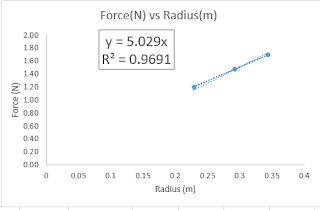Daniel Guzman
Alejandro Rodriguez
Rodrigo Uribe
March 29, 2017
Purpose
In this lab, we are trying to learn the relationship between centripetal force and angular speed.
Introduction
In this lab,we are trying to figure out the relationship between the angular velocity, the mass of the object in motion and radius ( or the distance the object is from the center).
Procedure
First, we set up our apparatus as shown below.
Then we put a piece of tape on the rim of the disk, so the that it passes through the photo gate. This will help us determine the rotational period of the disk.
Next, we put a wireless force sensor on the disk and then turn on the disk so it can go constant speed, zero the force sensor. Now let the come to a constant speed and record that. We tied a string to the center at one end and at the other end, we tie it the mass. When collecting data we want to collect data in such a way that :
- we have a variety of masses at fixed constant speed and radius. ( which we can see how mass have an effect when mass changes)
- have the same mass at the same constant speed but with a different radius each time ( how the change in radii affect our data)
- have the same mass and same radius but at different rotational speeds ( we can get this by adjusting a voltage on our power supply. This shows the effect of changing rotational speed)
We were able to get the angular frequency by subtracting the period it took for 1 rotation of the disk from when disk rotated 10 times from the initial rotation. Then we divided by 10 ( since its 10 rotations). Next we divided this value we got from 2 Pi, to get our rotational frequency.
After we got out measurement, we decided to graph by letting one values out of the three ( mass, radius and rotational speed) to be constant with Force and graph that, causing the slope to be one of the respective values
In this case, we use the various mass values and graph that against Force which would help us get the angular velocity times radius to be the slope
In the next case, we put radius against force and graph that to get the slope to be (constant m, and angular velocity).
Next, we had the angular velocity vs Force graph and we graph this. The slope of this line would be (constant m,r).
Conclusion
I believe that since there was some discrepancy when recording the data for angular velocity, we cannot say that the Force vs. W graph is accurate since the slope should be constant. We can fix this by changing the W here with the ( m,r ) values to get a constant slope. I learned in this lab that if we change one of the variables in rotational motion, we can determine the other two variables by the methods we used in this lab.








No comments:
Post a Comment